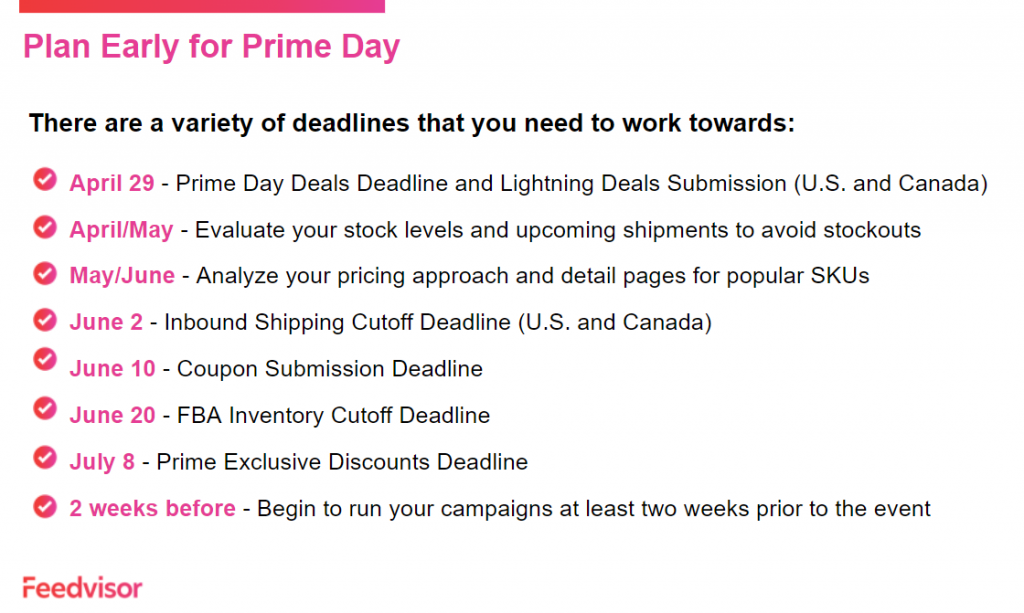Resources - Blog
4 Steps to Stay Ahead in the Retail Landscape [Webinar Recap]

Stay on top of the latest e-commerce and marketplace trends.
Amazon will account for nearly 40% of total US retail e-commerce sales in 2022, according to an eMarketer forecast. As such, brands are turning to Amazon as a critical part of their e-commerce strategies.
The Amazon platform has a lot to offer brands, including a variety of choices and a high return on investment for advertising. As revealed in Feedvisor’s latest report, “Brands, Amazon, and the Changing Landscape of E-Marketplaces: 2022 Report,” 58% of brands see great value in Amazon Advertising.
But as competition intensifies and the online marketplace sector changes rapidly, what can you do to adapt and succeed?
In this webinar, Feedvisor’s President and Chief Operating Officer Dani Nadel dives deep into this groundbreaking data to provide actionable tips that you can use in your advertising and media strategies to counteract supply chain disruptions and prepare for upcoming tent-pole events like Amazon Prime.
Nearly half (45%) of brands take advantage of Amazon in their current retail strategies
The Relationship Between Amazon and Brands
Nearly half (45%) of brands take advantage of Amazon in their current retail strategies, according to our new report taken from a survey of more than 1,000 U.S. brands – from direct-to-consumer companies to Fortune 1000 companies.
The relationship between Amazon and brands has changed over the years, and more brands are now willing to find a way to utilize Amazon. Of brands not currently selling on Amazon, 15% want to start in 2022, and 31% expect to start selling in the next three years, showing interest in investing in Amazon for short-term and long-term strategies.
For some brands, Amazon is a lifeline to increasing their online sales. Close to half of surveyed brands complete over 50% of their e-commerce sales through Amazon – a five percentage point increase since 2019.
Some of the reasons why brands are deciding to incorporate Amazon into their strategies include:
- Increased sales (96%)
- Gaining market share (94%)
- Acquiring new customers (93%)
- Generating brand awareness (93%)
Key Challenges for Brands in 2022
The pandemic has exacerbated many of the challenges of e-commerce. According to recently surveyed brands, the top five e-commerce challenges in 2022 are as follows:
- Supply chain logistics (38%)
- Meeting customer demand (36%)
- Shipping and fulfillment (31%)
- Acquiring new customers (27%)
- Building and maintaining customer loyalty (24%)
None of these challenges are surprising for anyone who works in the e-commerce industry, but let’s see how they compare to the challenges that brands have selling on Amazon:
- Increased competition (74%)
- Marketplace fees (70%)
- Inability to control the customer experience (69%)
- Lower profit margins (68%)
- Amazon’s exclusive or private label products (67%)
Although increased competition is not noted as a top challenge for the e-commerce industry; it ties directly to concerns with acquiring new customers. Many of the challenges indicated above by brands are increasing concerns across popular online marketplaces like Walmart and Target.
As competition intensifies across e-marketplaces, what can you do to adapt and succeed? Continue reading for the four steps brands can take to stay ahead to capitalize on available opportunities and solve the challenges brands are facing in 2022.
4 Steps to Stay Ahead in the Ever-Evolving Retail Landscape
1. Focus on Channel Diversification
Brands are using channel diversification strategies to keep up with competitors and reach their target audiences. By implementing e-marketplaces, you can drive sales (46%), acquire new customers (45%), and build brand awareness (45%).
There isn’t any time left to ease into different channels slowly. You must be more aggressive in your expansion strategy. Brands are now on at least one marketplace other than their own online store, and Amazon is a necessary channel to include in diversification.
Including Amazon in Channel Diversification
Nearly half (45%) of brands take advantage of Amazon in their current retail strategies, and for a good reason. Here are a few reasons why brands are choosing to include Amazon in their strategies:
- 96% of brands see Amazon as a growth engine, saying the best part about selling on Amazon is the increased sales volume
- 92% of consumers say they are more likely to buy products from Amazon than from any other e-commerce site
- 53% of Brands advertising on Amazon see an average return of 7x’s or more
Although Amazon is necessary to most e-marketplace strategies, it alone is not sufficient. Brands are commonly selling on the trio, Amazon (45%), Walmart (25%), and Google (21%).
How to Diversify Your Channels
Diversifying your channels does add complexity, but here are some steps you can take to begin expanding.
- Use Amazon in your retail strategy to acquire new customers, examine your investment strategy and performance and see how you can optimize
- Select two or more marketplaces whose audience best fits your target and experiment
- Look for ways to stand out
- Analyze baseline ad spending percentages to guide your allocations for advertising funds
- Use social and mobile as complimentary channel opportunities; drive to marketplaces
2. Focus on Supply Chain Logistics
The most significant challenge for brands in 2022 is supply chain logistics. Since the start of the pandemic, inventory concerns and out-of-stock messages have been incredibly prevalent.
Low stock availability can significantly impact product ranking and sales, inactive PPC campaigns, and loss of loyalty. In fact, 65% of consumers said they purchased products from brands they hadn’t previously tried before during the pandemic.
Despite the supply chain and inventory setbacks, 64% of brands selling on Amazon saw an increase in sales and revenue, and nearly half (49%) saw a sales increase of 11% or more.
What can you do to remain successful amidst supply chain logistics?
It sounds simple, but plan in advance, especially for big shopping events like Amazon Prime Day.
Here are some tips you can use to start your planning:
- Learn from the past holidays. Are there trends from past Prime Days or Cyber 5 that you can use to inform your strategy for the upcoming Prime Day 2022?
- Reevaluate your inventory strategy. It can take three weeks to make up for the impact of a low inventory of out-of-stock products. Add two to three weeks to your own business supply chain could help you ward off supply chain problems
- Implement “Supply Chain Aware” advertising. Create an advertising strategy that is supply chain “aware” by using advertising and deals to solve supply chain logistic challenges like using ads to direct consumers to in-stock products and promote early holiday deals to spend less on PPC and lessen the holiday-delivery rush.
Using these strategies together helps ensure shoppers find your brand’s in-stock products and receive gifts on time, leaving you with happier reviews and a higher organic ranking and success potential for winning the buy box.
3. Experimentation with Advertising Types & Channels
Ads are an integral part of any business strategy and remain crucial to the profitability and brand awareness of brands and sellers in the future. Those who take advantage of Amazon’s advertising business, now the third-largest digital advertising platform in the U.S. behind Google and Meta (formerly Facebook), will have the upper hand.
Amazon has a scaling ad business, with 89% of all retail media ad spend currently commanded by Amazon, and competition is still expanding, evidenced by rising CPCs. In 2021, CPCs rose 56% YoY while ad spend rose 49%, and ACoS rose 20%.
When you consider both the higher competition and rising CPCs, is it worth it to advertise on Amazon? Brands say yes, with 74% of brands finding success on Amazon advertising.
How to Experiment with Advertising Types and Channels?
Video and audio are the latest opportunities for advertisers to reach consumers. The way consumers view content has changed irrevocably where the preference is now content that is interactive, entertains, and informs.
Experiment with varying types of advertising and channels. Sticking with one ad type will leave you with missed opportunities to stand out. It’s time to drive greater returns or spend less on paid.
Here are a few strategies to experiment with advertising types and channels:
- Explore a mix of ad formats and ad types at each funnel stage
- Try video and audio ads for both on and off-platform reach
- Use Amazon’s tools like AMC and Amazon Attribution for deeper learning about your channel effectiveness and consumer paths
- Leverage your technology and expertise
Further Reading: A Guide to Advertising on Amazon in 2022
4. Maximize Tent-Pole Events and Holidays Early
Holidays are still the time brands see the highest returns. The return of Prime Day to summer has been a massive success, with total online retail sales in the U.S. exceeding $11 billion during Amazon Prime Day alone, and 47% of brands saw an increase in sales.
Last year’s June Prime Day beat the most recent Cyber Monday ($10.7 billion) in sales, showing how integral the sales event can be for brands’ strategies and the importance of planning for the holidays.
How to Maximize Success for Amazon Prime Day 2022
Plan early for Prime Day. While we have already shared these Amazon Prime Day 2022 dates on a previous blog, it warrants repeating. There are a variety of deadlines that you need to work towards, even if we don’t yet know when Amazon Prime Day will be.

What You Can Do Before Big Tent-Pole Events like Prime Day or Holiday?
We recommend experimenting with your ads before big holidays like Prime Day, so you have time to optimize.
Here are a few things you can do to prepare:
- Evaluate your catalog, advertising efforts, actuals to forecast, competitors, SOV, consumers
- Experiment with new formats, creative approaches, and content
- Get “Seasonally” retail-ready
- Think of Prime Day as a Three-Phased Event (lead-in, 48 hours, lead-out) and evolve your strategy
But you shouldn’t be waiting for the holidays to optimize your advertising, as 43% of brands consistently advertise throughout the year.
Further Reading: When is Prime Day 2022? We Make Our Prediction
Final Thoughts
To access all these insights and more, download the 2022 Report: Brands, Amazon, and the Changing Landscape of E-Marketplaces.
